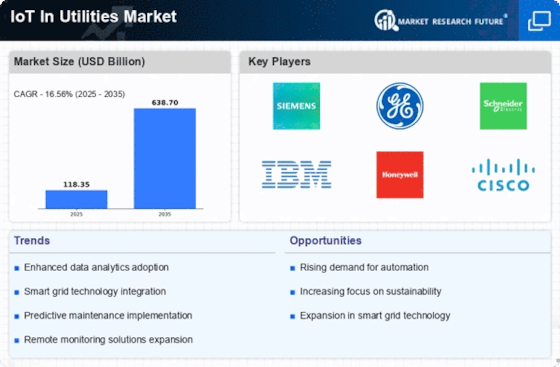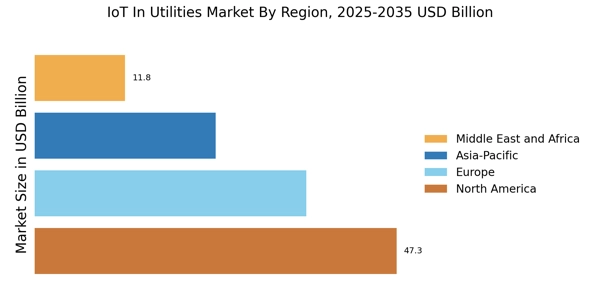Enhanced Cybersecurity Measures
As the IoT In Utilities Market expands, the importance of cybersecurity cannot be overstated. The increasing interconnectivity of devices and systems exposes utilities to potential cyber threats, necessitating robust security measures. Utilities are investing in advanced cybersecurity solutions to protect sensitive data and ensure the integrity of their operations. The market for cybersecurity in the utilities sector is projected to grow significantly, reflecting the rising awareness of cyber risks. By implementing comprehensive security protocols, utilities can safeguard their IoT infrastructure, thereby enhancing consumer trust and operational resilience. This focus on cybersecurity is likely to shape the future of the IoT In Utilities Market, as stakeholders prioritize secure and reliable service delivery.
Growing Focus on Sustainability
Sustainability has emerged as a central theme in the IoT In Utilities Market, driven by increasing environmental awareness among consumers and businesses. Utilities are under pressure to adopt sustainable practices, and IoT technologies play a crucial role in this transition. By utilizing IoT solutions, utilities can monitor and manage resources more effectively, reducing their carbon footprint. The market for IoT-enabled sustainability solutions is expected to expand, with investments in smart water management and energy-efficient systems on the rise. This focus on sustainability not only aligns with consumer expectations but also helps utilities comply with stringent environmental regulations. As sustainability becomes a priority, the IoT In Utilities Market is likely to witness accelerated growth and innovation.
Advancements in Smart Meter Technology
The evolution of smart meter technology is a pivotal driver in the IoT In Utilities Market. Smart meters facilitate two-way communication between utilities and consumers, enabling real-time data collection and analysis. This technology not only enhances billing accuracy but also empowers consumers to monitor their energy usage patterns. The market for smart meters is projected to grow significantly, with estimates suggesting a compound annual growth rate of over 10% through 2025. As utilities increasingly deploy these devices, they can leverage the data to improve demand response strategies and enhance grid reliability. The proliferation of smart meters is thus a critical factor in the ongoing transformation of the utilities sector, fostering greater engagement between providers and consumers.
Increased Demand for Energy Efficiency
The IoT In Utilities Market is experiencing a notable surge in demand for energy efficiency solutions. As consumers and businesses alike seek to reduce energy consumption and lower costs, IoT technologies provide real-time monitoring and management capabilities. This trend is evidenced by the projected growth of smart grid technologies, which are expected to reach a market size of approximately 61 billion USD by 2026. The integration of IoT devices allows utilities to optimize energy distribution, thereby enhancing operational efficiency and reducing waste. Furthermore, regulatory frameworks are increasingly favoring energy-efficient practices, compelling utilities to adopt IoT solutions to comply with new standards. This growing emphasis on energy efficiency is likely to drive innovation and investment in the IoT In Utilities Market.
Regulatory Support for IoT Integration
Regulatory frameworks are increasingly supportive of IoT integration within the utilities sector, acting as a catalyst for growth in the IoT In Utilities Market. Governments are recognizing the potential of IoT technologies to enhance service delivery and operational efficiency. For instance, various initiatives aim to promote smart grid development and renewable energy integration, which are heavily reliant on IoT solutions. This regulatory backing not only encourages investment in IoT infrastructure but also facilitates collaboration between public and private sectors. As a result, utilities are more inclined to adopt IoT technologies, leading to improved service reliability and customer satisfaction. The alignment of regulatory policies with technological advancements is likely to shape the future landscape of the IoT In Utilities Market.


















Leave a Comment